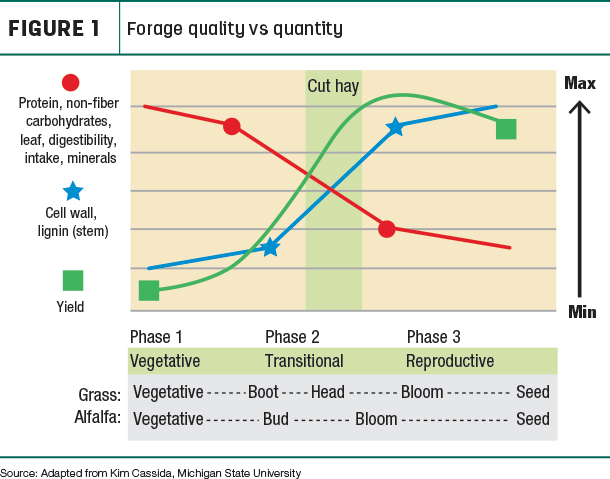Hay season will soon be upon us; how will your forage perform? This question is on the mind of growers who raise, feed and sell this precious commodity.
Hay and forage is an essential part of a livestock operation, and growers are encouraged to test forage growth in the spring, before first cutting, as a vital first step to ensure hay season goes well.
The technology of near-infrared spectroscopy (NIR) is an important method in feed analysis that allows for rapid and cost-effective evaluation of the nutrients livestock consume. NIR is the characterization of many important nutrients and that, as growers look to their first cutting of alfalfa, there are ways to find and analyze the nutrient levels growers want to hit.
People typically test after they’ve baled and the quality and quantity is what it is. We can’t change anything at that point. We encourage growers to test before they cut so they can optimize the quality with more desirable levels of nutrients to feed to livestock or sell it and get paid a premium for a higher-quality product.
To hit the sweet spot of quality and quantity, hay should be cut between the time of the late boot stage (emergence from the leaf sheath) and full seedhead expression, before flowers begin to open and release pollen. This tends to be at the 12- to 14-inch height stage for alfalfa (Figure 1).

For our clients, we recommend scissor cutting a quick sample, clipping alfalfa 3 inches above the ground or where the cutter bar is set. Bermudagrass should be clipped between 3.5 and 4 inches from the ground to not disturb the stolons. It is important to cut samples from random places across the field and combine them into one sample to get a true representation of the whole field.
Samples should be sent to a reputable lab such as ours, and it is important to find lab analysis that provides feedback from the sample within 48 hours. This allows growers to decide when to cut to reach both relative feed value (RFV) and relative feed quality (RFQ) targets.
Continuing to test alfalfa and other hay types throughout the season will give growers the best results for this seasonal business. The right time to cut hay cannot be determined by looking at the height of the grass because each time the hay grows between cuttings, there is an opportunity to cut at better-quality times for ideal protein and fiber digestibility.
In addition, growers should take two samples per week until it falls into the RFV and RFQ growers are looking for. Good producers should have a target in mind.
The University of Wisconsin Extension has analyzed forage quality changes with advancing maturity over time across each harvest of alfalfa for several years and recently published a statement that quality of first cutting changes at the fastest rate, while later cuttings change in fiber and digestibility at a slower rate.
Specifically, the University of Wisconsin Extension study states first cutting decreases 5 points RFV per day, the second cutting decreases 2 to 3 points per day, and third and fourth cutting during the growing season declines 1 to 2 points per day. RFQ will change about the same as RFV on first cutting, then decline about 4 points per day on second, third and fourth cuttings during the growing season.
Having healthy soil helps support the growth of hay. To produce the best quality of hay possible, a grower can also partner with an agronomist to soil test and determine what level of fertilizer is needed of different elements for peak growth.
And remember, grazing and cutting hay continually removes nutrients from the soil. Soil testing provides data as to what levels of nutrients a grower needs to add back to the field.









